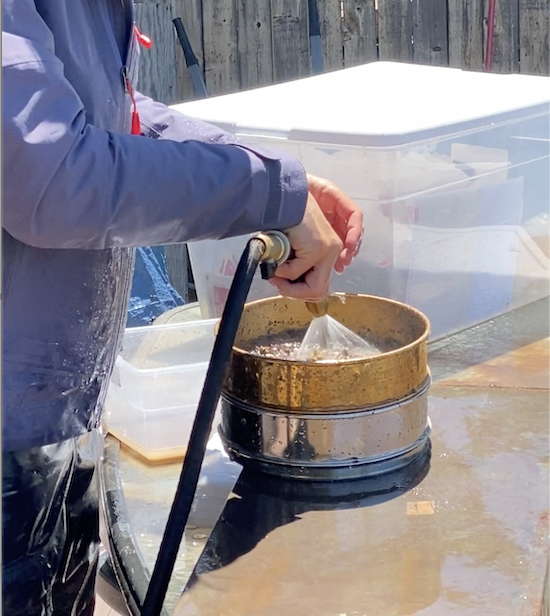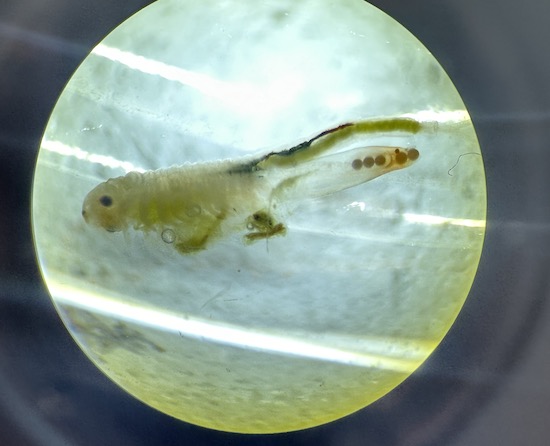DRY SEASON SURVEYS
To determine the presence of endangered California fairy shrimp
FAIRY SHRIMP DRY SEASON "SURVEY" GUIDE
While "dry season surveys" can simply mean the collection of soil from dry pools, that is in fact only the first of several steps in performing full United States Fish & Wildlife Service (USFWS) protocol-level "dry season surveys". As outlined below, the full dry survey process involves soil processing, cyst isolation, microscope cyst identification, and cyst chilling, hatching and rearing for identification purposes. Only those with "special terms and conditions" for these procedures listed on their USFWS permit can perform steps 2-4 below.
STEP 1
SOIL COLLECTING
- In-field soil collection from vernal pools or ponded basins
- Soil is shipped to our lab
Most fairy shrimp permit holders
STEP 2
SOIL PROCESSING
- Soil is rehydrated
- Soil is filtered through a series of sieves to separate out cysts
- Material is decanted onto a filter and then looked at under a microscope to determine if cysts are present and if so, which species
Permit needs Special Terms & Conditions listed
STEP 3
CYST CHILLING
- If Branchinecta cysts are found, they are moved to individual basins and rehydrated
- Basins soak in a chilled environment for 4-6 days
Permit needs Special Terms & Conditions listed
STEP 4
CYST REARING
- After the chill period, cysts are removed from the cold and placed on the laboratory bench
- Cysts hatch and are fed and cared for as they grow to mature adults, when identification to species is in then possible
Permit needs Special Terms & Conditions listed
DRY SEASON SURVEYS
OUR SERVICES
We provide the FULL range of dry season survey services, steps 1 - 4 above, for fairy shrimp species in California to assist clients in determining if endangered species are present.
We also perform wet season surveys.
While these surveys are known as "dry season surveys", they are technically so much more than that. A "dry season survey" can simply be the collection of soil from the dry vernal pools. The full survey process, however, involves soil processing and cyst isolation, chilling, hatching and rearing for identification purposes.
Our customized, high tech lab offers these services with top-notch results. We are also capable of handling high volumes of soil thanks to automated processes.
With a 100% acceptance rate of our work and reports by USFWS, your project is in good hands!
STEP 1: SOIL COLLECTION
The first step is to collect soil from the vernal pools or ponded basins of the project area. Anyone holding a Recovery Permit for fairy shrimp should be authorized to collect the soil as long as they follow the USFWS collection guidelines. Ecological Soil Labs can also collect the soil for you.

STOP! You cannot proceed any further with a Scientific 10(a)1(A) Recovery Permit for fairy shrimp with special terms and conditions listed!! Very few people possess these additions to their permit (so we recommend asking first).
GOOD NEWS! WE HAVE THE REQUIRED SPECIAL TERMS AND CONDITIONS.
Ecological Soil Labs owner Chez Brungraber holds a valid USFWS Scientific Recovery Permit with Special Terms & Conditions listed to process soil and raise fairy shrimp cysts. Further, the investment in our lab shows - we can process up to 3000 samples/week and have customized equipment to prevent sample/cyst cross-contamination and algal overgrowth during the culturing phase.
Working with Ecological Soil Labs, you can now proceed and we can do the rest of the dry season survey work for you!
STEP 2: SOIL PROCESSING
The soil processing procedure involves soaking the soil in water, sometimes overnight, to thoroughly separate any potential cysts from the soil substrate. This soaking allows clay-based soils to rehydrate, enabling the cysts to naturally detach without causing harm.
After the soil has soaked and been fully kneaded to eliminate clumps, it is passed through a series of sieves. The sieve size is selected based on the target species for the survey and the range of those cyst sizes. The soil is carefully rinsed through the sieves to avoid damaging the cysts or forcing them through the sieve instead of capturing them.
Once the soil has been filtered, it is transferred onto coffee filters and the contents are examined under a microscope. This is the point of determination: if Branchinecta cysts are found, the process moves on to Steps 3 and 4. If no cysts are detected, it is concluded that no fairy shrimp are present, and the process ends. If non-Branchinecta cysts are found, many can be identified to species based on their appearance and the location of the sample. For example, the only known Streptocephalus species in southern California is Streptocephalus woottoni. In this case, hatching and rearing are unnecessary, and the process concludes.

STEP 3: CYST CHILLING
Once Branchinecta cysts have been identified, they need to have a chilling period before they will reliably hatch. This ecological trick prevents them from hatching in the hours after a summer thunderstorm ponds their habitat and then living only for a few hours!
Cysts are placed into labeled basins and moved into a specialized chill area for several days. After sufficient chilling time, cysts are moved to the laboratory bench for hatching.
STEP 4: CYST HATCHING
Once the cysts are placed in their basins on the laboratory bench, they are carefully monitored, aerated, and fed as necessary. Our custom aeration bubblers help prevent algal overgrowth, which can be fatal to fairy shrimp. We also regulate temperature and light to give the shrimp the best chance of reaching adulthood.
After approximately 8 to 14 days, the shrimp are mature enough for species identification. Our proprietary method does not require sacrificing the shrimp for identification. Instead, they are observed and identified, then returned to their basins, where they continue to live out their natural lives.

DRY SEASON SURVEYS
PRICING
While our pricing is dependent upon the nuances of your project, including pool size, location, access, and potential/target species, what we can tell you is that pricing is mostly determined by the number of soil samples, aka, the amount of soil we need to process.
The effort level of dry season surveys is directly related to how much soil needs to get filtered through the sieves. The more soil, the more work! Bigger pools don't offer much cost discount (and be weary of those who offer it or those who give you pricing per pool without knowing the pool size first! Some corners might be getting cut there) because the bigger the pool, the more samples. The caveat, of course, is that total number of soil samples do max out with very large pools, so you will never collect more than 100 samples from a single pool, no matter how large. In this case, the cost savings of dry verses wet season go up immensely!
Here is the USFWS's sampling table:

As cited from USFWS's fairy shrimp presence-absence survey protocol, Survey Guidelines for Large Listed Branchiopods 2017.
WHAT ARE FAIRY SHRIMP?
Learn all about fairy shrimp, the difference of wet and dry season surveys, and more.
By the Numbers
